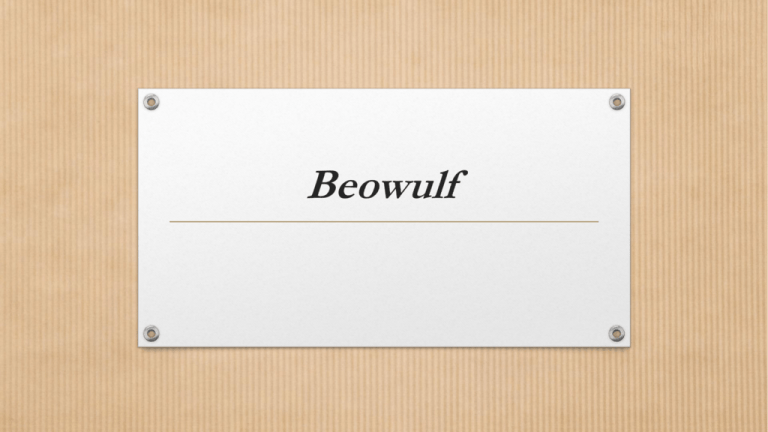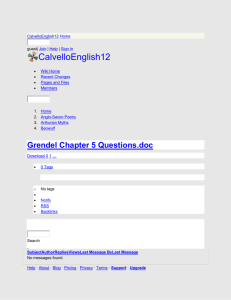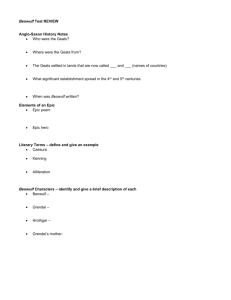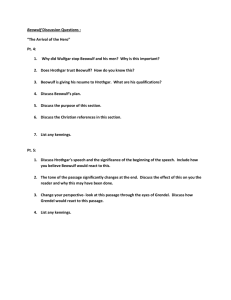Beowulf: An Introduction to the Epic Poem
advertisement

Beowulf Background • • • • Epic Oldest surviving English poem Best example of Anglo-Saxon culture Probably composed between 700 A.D. and 900 A.D. Structure • Approximately thirty-two hundred lines (short for an epic; Homer’s around 15,000) • Chronologically in two halves- Beowulf when young and Beowulf when old • Action- wise in three sections-1. Exposition and Grendel conquest 2. Battle with Grendel’s mother 3. Beowulf ’s battle with the dragon Structure (the excerpts we will read) • • • • • • • • • The Wrath of Grendel (pages 40-44) The Coming of Beowulf (pages 44-48) Unferth’s Challenge (packet) The Battle with Grendel (pages 44-51) The Monsters Lair (pages 51-52) The Battle with Grendel's Mother (pages 52-56) The Last Battle (page 56-51) The Spoils (pages 61-62) The Farewell (pages 63-64) Anglo-Saxon Culture • Wyrd- a concept in Anglo-Saxon culture roughly corresponding to fate or personal destiny. • Comitatus-a Germanic code of loyalty. Warriors, or thanes, swore loyalty to their king, for whom they fought and whom they protected. In return the king was expected to be generous with gifts of treasure and land. • Wergild- Germanic custom of paying wergild or “man-payment” is the practice of paying a slain man’s family to atone for the deed and to prevent them from taking revenge against the manslayer. For example, before the events of the poem, Hrothgar paid a wergild to Beowulf's father. Hence, Beowulf feels compelled to help Hrothgar in his time of need. Anglo-Saxon Culture • Anglo-Saxons had an oral tradition kept alive by Scops (pronounced shope ) Scops would tell and retell stories like Beowulf. This created a central reference point for Anglo-Saxon culture. Listening to Beowulf, an Anglo-Saxon could learn of bravery and loyal to one’s fellows, of the monsters that spite and hatred could breed, and of the heroism needed to conquer such monsters. Setting • The Dark Ages between 500 A.D. and 700 A.D. • 1st Danish kingdom ruled by Hrothgar on the island of Zealand (present day Denmark) • The mead hall, Herot • Lake • 50 years later in the land of the Geats in Sweden Literary Focus • • • • • • Epic –long narrative poem (see other notes) Epic hero (see other notes) Alliteration –repetition of initial consonant sounds Assonance – repetition of vowel sounds Kenning –metaphorical compound renaming of a noun Archetype –old imaginative pattern passed through the ages; can be a character type or plot or image • Allusion-reference to something that came before • Symbol- something that stands for something larger than self • Appositive-normally noun phrases, are placed side by side, with one element serving to identify the other in a different way • • • • • • Figurative language – simile, metaphor, personification Apostrophe-addressing someone or something absent Theme Imagery-language that appeals to the senses Caesura –pause Foil-contrasting characteristics Characters Danes • From Denmark • Hrothgar-king of the Danes • Unferth –drunken Dane who challenges Beowulf • Welthow- Hrothgar's wife, queen of the Danes Geats • • • • • From Sweden Beowulf- protagonist, heroic warrior Higlac- Beowulf's feudal lord Wiglaf – Beowulf ’s Edgetho – Beowulf ’s father Characters The Monsters • Grendel • Grendel’s mother • The dragon Point of View • 3rd person omniscient • Christian perspective in a pagan culture






